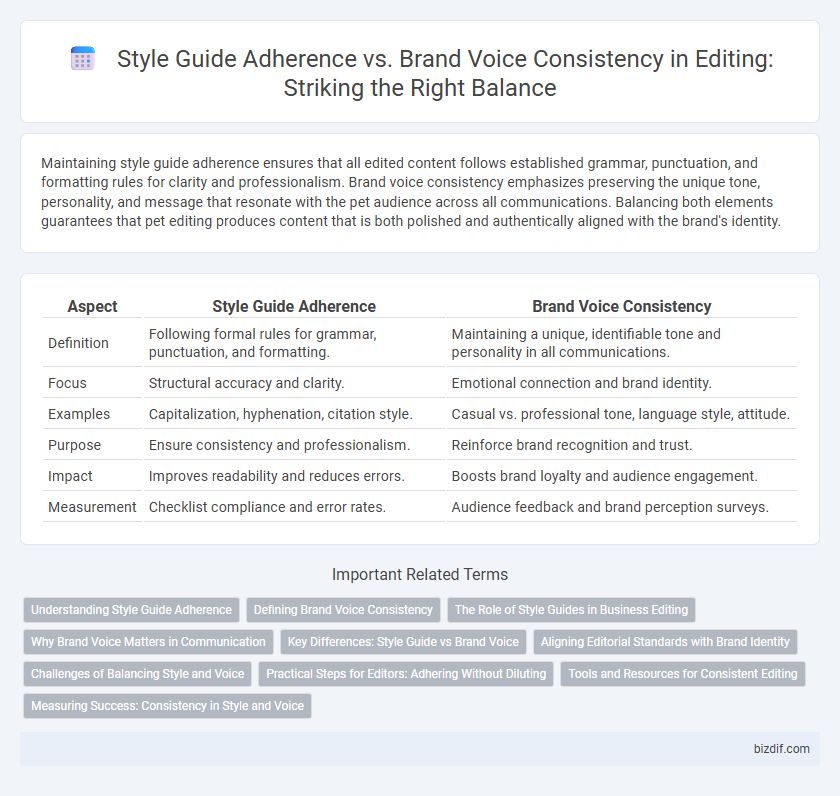Maintaining style guide adherence ensures that all edited content follows established grammar, punctuation, and formatting rules for clarity and professionalism. Brand voice consistency emphasizes preserving the unique tone, personality, and message that resonate with the pet audience across all communications. Balancing both elements guarantees that pet editing produces content that is both polished and authentically aligned with the brand's identity.
Table of Comparison
| Aspect | Style Guide Adherence | Brand Voice Consistency |
|---|---|---|
| Definition | Following formal rules for grammar, punctuation, and formatting. | Maintaining a unique, identifiable tone and personality in all communications. |
| Focus | Structural accuracy and clarity. | Emotional connection and brand identity. |
| Examples | Capitalization, hyphenation, citation style. | Casual vs. professional tone, language style, attitude. |
| Purpose | Ensure consistency and professionalism. | Reinforce brand recognition and trust. |
| Impact | Improves readability and reduces errors. | Boosts brand loyalty and audience engagement. |
| Measurement | Checklist compliance and error rates. | Audience feedback and brand perception surveys. |
Understanding Style Guide Adherence
Style guide adherence ensures uniformity in grammar, punctuation, and formatting across all documents, enhancing clarity and professionalism. It sets standardized rules that help editors maintain consistency regardless of varied content types or authors. Understanding these guidelines is crucial for aligning content with organizational standards while preserving the intended message and tone.
Defining Brand Voice Consistency
Defining brand voice consistency involves establishing a distinct, recognizable tone and personality that aligns with the company's values and resonates across all communication channels, ensuring a cohesive audience experience. It requires detailed documentation of language preferences, emotional tone, and message style to maintain uniformity in content creation. Unlike style guide adherence, which enforces grammatical and formatting rules, brand voice consistency centers on preserving the unique identity and emotional connection of the brand throughout every editorial piece.
The Role of Style Guides in Business Editing
Style guides provide a structured framework ensuring consistency in grammar, punctuation, and formatting, which enhances clarity and professionalism in business editing. Brand voice consistency aligns messaging tone and personality with organizational identity, fostering trust and recognition among target audiences. Integrating style guide adherence with brand voice strategies enables editors to deliver coherent and authentic content that supports marketing and communication objectives effectively.
Why Brand Voice Matters in Communication
Brand voice consistency establishes a unique and recognizable identity that strengthens trust and emotional connection with the audience. Adhering consistently to the brand voice ensures all messaging reflects the company's core values and personality, enhancing clarity and coherence across communication channels. While style guides provide technical standards, brand voice shapes the tone and emotional resonance that distinguish the brand in a competitive market.
Key Differences: Style Guide vs Brand Voice
Style guide adherence ensures uniformity in grammar, punctuation, and formatting across all content, providing clear rules that maintain professional standards. Brand voice consistency reflects the unique personality and emotional tone of the brand, shaping how messages resonate with the target audience and reinforce brand identity. While a style guide standardizes technical aspects of writing, brand voice drives the subjective expression and emotional connection within communications.
Aligning Editorial Standards with Brand Identity
Aligning editorial standards with brand identity ensures style guide adherence while maintaining brand voice consistency. Clear guidelines integrate tone, language, and terminology to reinforce the brand's unique personality across all content. This synergy enhances audience recognition, trust, and engagement by delivering a coherent and authentic brand experience.
Challenges of Balancing Style and Voice
Balancing style guide adherence with brand voice consistency presents challenges such as maintaining uniform grammar and formatting while preserving the unique tone that defines the brand's identity. Editors must navigate strict style rules without diluting the emotional impact and personality embedded in the content. Achieving this balance requires careful calibration to ensure clarity, professionalism, and authentic brand resonance coexist seamlessly.
Practical Steps for Editors: Adhering Without Diluting
Editors can maintain style guide adherence while preserving brand voice consistency by creating a tailored style framework that integrates key brand elements with standard editorial rules. Practical steps include developing a comprehensive style checklist aligned with brand terminology, tone, and messaging, alongside regular training sessions to reinforce nuanced application. Utilizing collaborative review processes and real-time editing tools ensures each piece meets structural standards without sacrificing the authentic brand personality.
Tools and Resources for Consistent Editing
Utilizing advanced tools like Grammarly, Hemingway Editor, and ProWritingAid enhances style guide adherence by flagging grammar, punctuation, and formatting errors according to specific brand standards. Brand voice consistency is maintained through customized style sheets, tone analyzers like Acrolinx, and collaborative platforms such as Google Docs or Adobe Creative Cloud that facilitate real-time feedback and revisions. Integrating these resources streamlines the editing process, ensuring uniformity across all content while respecting unique brand identity nuances.
Measuring Success: Consistency in Style and Voice
Measuring success in editing requires evaluating both style guide adherence and brand voice consistency to ensure clarity and authenticity across all content. Key performance indicators include error rates, tone alignment scores, and reader engagement metrics that reflect the intended brand personality. Regular audits and AI-driven tools help quantify consistency, offering actionable insights to refine editorial standards and maintain cohesive communication.
Style guide adherence vs Brand voice consistency Infographic

 bizdif.com
bizdif.com